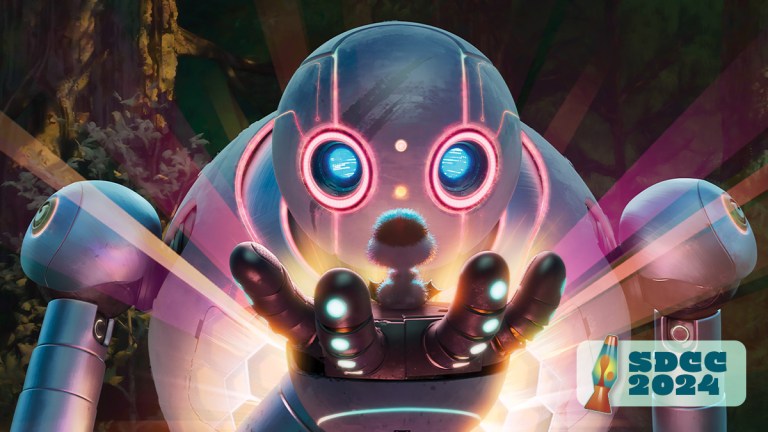The Wild Robot: First Look at Dreamworks’ Next Animated Epic
The team of artists behind The Wild Robot has worked to make it, like its titular character, more than the sum of its parts. Director Chris Sanders gives us an inside look at the animated movie.

This article appears in the new issue of DEN OF GEEK magazine. You can read all of our magazine stories here.
During the earliest production stages of an animated movie, it is common to begin the process with a series of exploratory paintings.
“They are abstract and loose and just delicious paintings,” says Chris Sanders, the director of films such as Lilo & Stitch, How to Train Your Dragon, and The Croods. But something special happened during the production of Sanders’ latest film, The Wild Robot, while he was sitting in a meeting and being shown some of these conceptual paintings.
“Someone pushed a button,” Sanders recalls, “and one of them started to move. And the camera started pushing through it.” What Sanders had taken for a painting was actually a finished scene of the movie. “And I cannot put too fine a point on it; I really didn’t think that was a piece of our finished film until that happened, and I realized, ‘My God, we’ve done it.’”
Painting a Movie
As shocked as Sanders was, this was what he had asked of The Wild Robot’s production designer, Raymond Zibach—for a film that was indiscernible from those early conceptual paintings. The Wild Robot, based on the book by Peter Brown, is the story of Rozzum unit 7134, Roz for short (Lupita Nyong’o), a robot who finds herself washed ashore on a forest island after a shipwreck. Lacking human masters to serve, she sets about looking after the wildlife of the island.
“Peter Brown revealed quite a few things to us about why he wrote the book and what was going on in his head as he wrote it,” Sanders says of adapting the story. “What wasn’t put in the book is that in his mind, he was operating under the premise that kindness can be a survival skill.” While recent cinema history is full of stories about lovable animated robots, the unique environment Roz finds herself in required a unique style of animation.
“With The Wild Robot, it was important to me that this piece of high technology really feel like it was lost in the wilderness,” Sanders says. “So we needed the biggest contrast we could get, meaning a forest that looks organic.”
For Sanders, the benchmark of organic animated forests was set by Tyrus Wong’s animated backgrounds in Disney’s Bambi and the painted backgrounds of Hayao Miyazaki in My Neighbor Totoro and Spirited Away, and that is what the art style of The Wild Robot aspired to.
“Any animated film you see, I guarantee that what you see on the screen represents the outer limit of the available technology,” Sanders tells us. “With The Wild Robot, I would be so bold as to say that we have closed the circle that began with Snow White and Bambi, [and] through films like The Lion King, Lilo & Stitch, and Shrek. We’ve finally gone back to those analog painted environments. Everything in The Wild Robot was painted by hand, by a human holding a stylus instead of a brush, but hand-painted nonetheless.”
Call of the Wild
While the art is crucial to the story The Wild Robot tells, that part of the production comes relatively late in the moviemaking process.
“The first thing we do is the voices. The voice is recorded before anything moves,” Sanders explains. The most important of those voices is, of course, Lupita Nyong’o’s.
“Lupita worked harder than anyone else to create the voice of the robot.” That effort was essential because, aside from her voice, Roz had few other ways to communicate her (artificial) feelings. “My only real direction [to modeling supervisor Hyun Huh] was I insisted she not have a mouth. I feel very strongly that in the absence of that articulation, we can see our emotions and see a reflection of ourselves in her.”
This meant the design of Roz was crucial, especially as the illustrations in the book leave so much to the imagination.
“The robot, as illustrated by Brown, is both vague and specific,” Sanders points out. “She has a very humanoid silhouette because Peter wants Rozzum robots to be humanoid. They operate in human places doing human jobs. But at the same time, his style is very graphic, so it was left to us to fill in the details on Roz.”
In addition to voices, The Wild Robot also tells a great deal of its story through music.
“I learned way back in Lilo & Stitch that the storytelling device that does the heaviest lifting can be music,” Sanders says. The composer for this project was Kris Bowers, whose work covers everything from Bridgerton and Secret Invasion to Green Book and The Color Purple.
“I said write me something orchestral that begins and develops and grows and is its own thing, and if there’s any problem with the way our visuals are working with that, I’ll deal with it later,” Sanders says. “I didn’t want something a character was doing to interrupt his music.”
Assembling the Robot
Sanders does all the jobs the director on a live-action movie would do, although admittedly, not always at the same time.
“Imagine a live-action set, take every one of those disciplines and just separate them,” he explains. “We move the camera first. We make the set and move the camera in space because we know from the storyboard what we want from a particular shot.”
From there, the animators create and animate more detailed models, all to fit the recordings of the voice actors. But the film doesn’t exist until all these disparate components are combined.
“It all comes together at the end,” Sanders says, “rather than me being on a set and yelling ‘Action’ and it all happening at once.”
The Wild Robot is out in US theaters on Sept. 27 and UK and Irish cinemas from Oct. 18.
